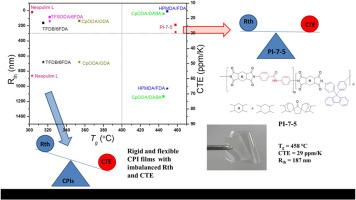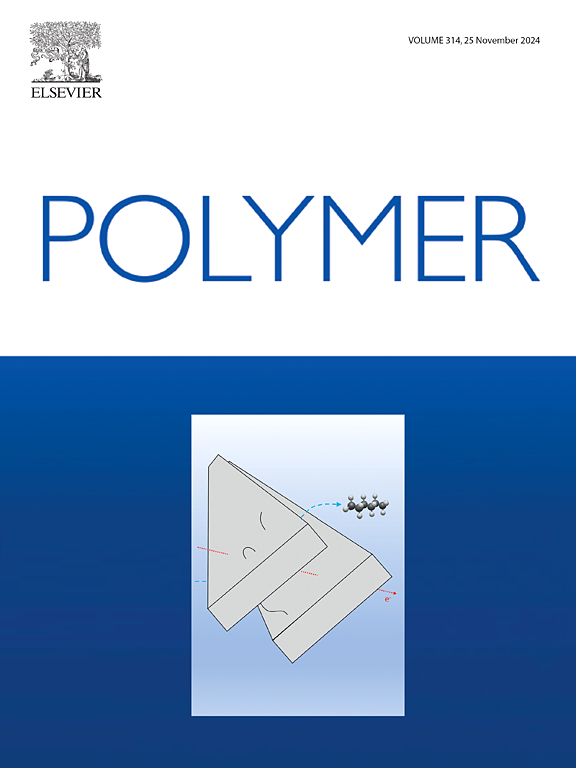Ultra-high Tg colorless polyimide film with balanced optical retardation and coefficient of thermal expansion for flexible display
IF 4.1
2区 化学
Q2 POLYMER SCIENCE
引用次数: 0
Abstract
Traditional colorless polyimide (CPI) films often have high coefficient of thermal expansion (CTE), high optical retardation (Rth) or low glass transition temperature (Tg) values. However, it remains challengeable to establish a balance between low Rth and low CTE without sacrificing the high Tg of CPI film for flexible display applications, especially for flexible thin-film-transistor liquid-crystal display (TFT-LCD) substrate. A set of colorless polyimides films are prepared from copolymerization of alicyclic dianhydrides hydrogenated pyromellitic dianhydride (HPMDA) and cyclopentanone bis-spironorbornane tetracarboxylic dianhydride (CpODA) with aromatic diamines 9,9′-bis (4-aminophenyl) fluorene (FDA) and 4,4′-diaminobenzanilide (DABA). The optical transparency, anisotropy and dimension stability of CPI films are initially optimized by adjusting the DABA-to-FDA molar ratios, and later by HMPDA-to-CpODA ratios. Tg trend analysis, d-spacing calculated from WAXD patterns, and the FTIR wavenumber shifts of the functional groups implied that the strength of hydrogen bonding is relatively higher in CpODA-based CPIs than the HPMDA systems, which may resulted in improved thermal properties of CPI films. It is shown that the polyimide PI-7-5 film displayed excellent comprehensive properties with an ultra-high Tg of 458 °C, low CTE of 29.0 ppm/K, and also a low Rth of 187 nm. Notably, it has a 90 % transmittance in the visible region, along with robust mechanical properties such as a tensile strength of 111 MPa, and an elastic modulus of 3.8 GPa, and good film folding reliability against extensive folding/unfolding cycles, making it an excellent choice for flexible TFT-LCD substrate.


传统的无色聚酰亚胺(CPI)薄膜通常具有高热膨胀系数(CTE)、高光阻(Rth)或低玻璃化转变温度(Tg)值。然而,在柔性显示应用中,尤其是柔性薄膜晶体管液晶显示器(TFT-LCD)基板中,如何在低 Rth 和低 CTE 之间取得平衡,同时又不牺牲 CPI 薄膜的高 Tg 值,仍然是一项挑战。由脂环族二酐氢化吡咯烷二酐(HPMDA)和环戊酮双铁硼烷四羧酸二酐(CpODA)与芳香族二胺 9,9'-双(4-氨基苯基)芴(FDA)和 4,4'-二氨基苯甲酰苯胺(DABA)共聚制备了一组无色聚酰亚胺薄膜。最初是通过调整 DABA 与 FDA 的摩尔比来优化 CPI 薄膜的光学透明度、各向异性和尺寸稳定性,后来又通过调整 HMPDA 与 CpODA 的摩尔比来优化 CPI 薄膜的光学透明度、各向异性和尺寸稳定性。Tg 趋势分析、WAXD 图谱计算出的 d 间距以及官能团的傅立叶变换红外波长移动表明,与 HPMDA 系统相比,CpODA 基 CPI 的氢键强度相对较高,这可能会改善 CPI 薄膜的热性能。研究表明,聚酰亚胺 PI-7-5 薄膜具有优异的综合性能,其超高 Tg 为 458 ℃,低 CTE 为 29.0 ppm/K,低 Rth 为 187 nm。值得注意的是,它在可见光区域的透射率高达 90%,同时还具有强大的机械性能,如 111 兆帕的拉伸强度和 3.8 GPa 的弹性模量,以及良好的薄膜折叠可靠性,可承受大量的折叠/展开循环,因此是柔性 TFT-LCD 衬底的绝佳选择。
本文章由计算机程序翻译,如有差异,请以英文原文为准。
求助全文
约1分钟内获得全文
求助全文
来源期刊

Polymer
化学-高分子科学
CiteScore
7.90
自引率
8.70%
发文量
959
审稿时长
32 days
期刊介绍:
Polymer is an interdisciplinary journal dedicated to publishing innovative and significant advances in Polymer Physics, Chemistry and Technology. We welcome submissions on polymer hybrids, nanocomposites, characterisation and self-assembly. Polymer also publishes work on the technological application of polymers in energy and optoelectronics.
The main scope is covered but not limited to the following core areas:
Polymer Materials
Nanocomposites and hybrid nanomaterials
Polymer blends, films, fibres, networks and porous materials
Physical Characterization
Characterisation, modelling and simulation* of molecular and materials properties in bulk, solution, and thin films
Polymer Engineering
Advanced multiscale processing methods
Polymer Synthesis, Modification and Self-assembly
Including designer polymer architectures, mechanisms and kinetics, and supramolecular polymerization
Technological Applications
Polymers for energy generation and storage
Polymer membranes for separation technology
Polymers for opto- and microelectronics.
 求助内容:
求助内容: 应助结果提醒方式:
应助结果提醒方式:


